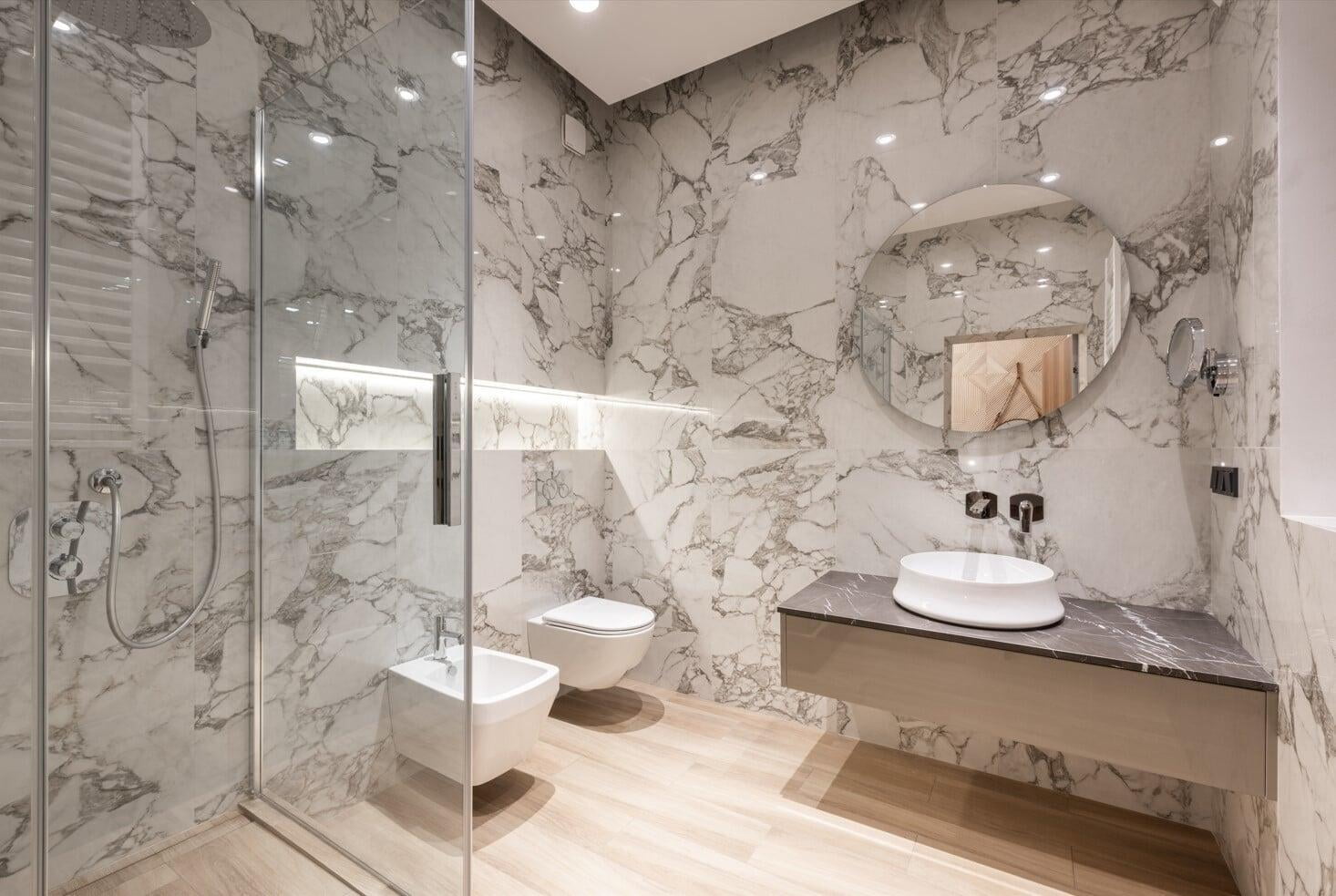
You must be wondering what the difference is between porcelain and ceramic tiles. They might look similar, but they're quite different when it comes to how they are made, how much water they absorb, their cost, and how long they last. If you're having trouble deciding between the two, this article is here to help you.
When it comes to showers, porcelain tile is the better choice. It's stronger and more durable than ceramic, making it less likely to crack or chip in high-moisture environments.
Porcelain or Ceramic Tile: Pros and Cons
Porcelain or Ceramic Tile: Pros and Cons
Porcelain Tiles
Porcelain Tiles
Porcelain tiles are a type of ceramic tile that is fired at very high temperatures to minimize their capacity to absorb water.
Pros
Porcelain tiles are extremely durable and hard-wearing, making them ideal for high-traffic areas.
Due to their low porosity, porcelain tiles are highly resistant to water and are therefore suitable for wet areas such as showers.
Porcelain tiles are less likely to stain as they are less absorbent.
Cons
Porcelain tiles are generally more expensive than ceramic tiles.
Because they are denser and harder, porcelain tiles are more difficult to cut and install than ceramic tiles.
Porcelain tiles can feel cold on bare feet, especially without underfloor heating in colder climates.
Ceramic Tiles
Ceramic Tiles
Ceramic tile is a type of hard, flat material made from clay and other natural minerals.
Pros
Ceramic tiles are less expensive than porcelain, making them a more affordable option
They are easier to cut and install due to their lower density
The ceramic tile's higher water absorption allows it to be used in cooler climates without underfloor heating
Ceramic tiles offer a greater variety in terms of colors, designs, and styles compared to porcelain tiles.
Cons
Ceramic tiles may not be suitable for high foot traffic areas due to their lower durability and resilience compared to porcelain tiles.
More susceptible to staining and damage caused by moisture
Main Differences: Porcelain vs Ceramic Tiles
Main Differences: Porcelain vs Ceramic Tiles
| Characteristic | Porcelain Tiles | Ceramic Tiles |
|---|---|---|
| Manufacturing Process | Made from kaolin clay and fired at very high temperatures resulting in extreme hardness and non-porosity | Made from a mixture of clay, natural materials, and additives, fired at lower temperatures resulting in a less dense and somewhat porous tile. |
| Firing temperature | - 2,200–2,500°F (1,200–1,370°C) | - 1,800–2,200°F (980–1,200°C) |
| Water Absorption Rate | Less than 0.5%, highly water-resistant | Higher (5–10%), less waterproof |
| Durability | Resistant to chipping, cracking, stains, and scratches Suitable for high-traffic areas | Durable but more prone to chipping and cracking Better for areas with less foot traffic |
| Cost | Typically more expensive due to durability and manufacturing process | More budget-friendly |
Which Tile is Ideal for a Bathroom Renovation on a Budget?
Which Tile is Ideal for a Bathroom Renovation on a Budget?
Ceramic tiles are a great option for those looking to renovate their bathroom on a budget. They offer many of the same advantages as porcelain tile and are usually less expensive.
In particular, glazed ceramic tiles are an ideal choice. The glaze provides extra protection against moisture and wear, making it more durable and long-lasting than unglazed ceramic tile.
Glazed tile also comes in a variety of colors and styles, allowing you to create the look you want without sacrificing quality. With proper care and maintenance, glazed ceramic tile can last for years, making it a great option for bathroom renovations on a budget.
Which Tile is Better for the Bathroom Floor?
Which Tile is Better for the Bathroom Floor?
Both porcelain and ceramic tiles can be effectively used for bathroom flooring. Their resistance to moisture and durability make them suitable choices for this space often subject to dampness.
However, porcelain tile is usually the best choice. It's more resistant to moisture, so it won't warp or swell like other types of tile. Porcelain is also a good shower floor tile. Its smaller size allows for more grout lines, adding extra slip resistance, which is an essential feature for shower floors.
Which Tile is Better for Shower Walls?
Which Tile is Better for Shower Walls?
Yes, both ceramic and porcelain tiles can be used for shower walls. Ceramic tiles, particularly glazed ones, offer an affordable and practical solution with a wide selection of colors and styles. On the other hand, porcelain tiles are denser and less porous, meaning they are even more resistant to water and staining.
Which Tile is Better in a High Traffic Area?
Which Tile is Better in a High Traffic Area?
When it comes to high-traffic areas, porcelain is generally the better choice between porcelain and ceramic tile. It's more durable than ceramic tile and can stand up to heavy foot traffic without cracking or chipping.
Which Option Requires Less Maintenance?
Which Option Requires Less Maintenance?
Both ceramic and porcelain tiles offer easy maintenance and longevity. If you're looking for a tile that requires minimal maintenance, porcelain is the way to go. Unlike ceramic, it's non-porous and scratch-resistant. This means it won't absorb moisture or dirt and will stay looking new even with heavy usage.
Which Is Easier to Install: Porcelain or Ceramic Tiles?
Which Is Easier to Install: Porcelain or Ceramic Tiles?
Porcelain tile tends to be slightly easier due to its larger size and uniform shape. This means that it's simpler to cut into the correct sizes and it fits together in a neater pattern. With ceramic, you may need to cut each tile individually or deal with variations in size which makes it more difficult to install.
Which Last Longer: Porcelain Tile Shower or Ceramic Tile Shower?
Which Last Longer: Porcelain Tile Shower or Ceramic Tile Shower?
In terms of longevity, both ceramic and porcelain tiles are known to last for many years with proper care, but there are some differences. Ceramic tile showers, although durable, usually last about 20 to 25 years if maintained regularly. On the other hand, porcelain tile showers, owing to their higher density and lesser porosity, can outlast ceramic tiles. They have an average lifespan of 50 to 60 years or more, making them an ideal choice for homeowners who prefer a long-lasting solution.
How to Distinguish Ceramic from Porcelain Tiles
How to Distinguish Ceramic from Porcelain Tiles
When it comes to high-traffic areas, porcelain is generally the better choice between porcelain and ceramic tile. It's more durable than ceramic tile and can stand up to heavy foot traffic without cracking or chipping.
Conclusion
Conclusion
Deciding between porcelain and ceramic tiles for your shower comes down to a combination of preference, budget, and where the tiles are going to be installed. Porcelain is harder than ceramic but also more porous. In general, porcelain tile has higher moisture absorption than ceramic tile due to its density which makes it better for high-traffic areas like entryways or shower stalls.
If you're on a tight budget then ceramic tile may be the right choice since it's usually less expensive while still offering good durability. Weighing all your options before purchasing is essential as there are several factors to consider when selecting what type of tile best fits your needs.
We'd suggest hiring a professional contractor if the installation will involve complex techniques like intricate designs or subway layouts. After all, it’s important to have the work done right for you to truly enjoy your new shower space. So why not take the next step and invest in professional help today?

